Management Accounting: Sales Price and Volume Variances, Material Price Variances, and Analysis of Variances
VerifiedAdded on 2023/01/07
|14
|3328
|40
AI Summary
This article discusses the computation of sales price variances, sales volume contribution variances, material price planning variance, and material price operational variance. It also analyzes the merits and demerits of using variances in determining managers' performance. The case study focuses on the make-or-buy decision for XLG organization.
Contribute Materials
Your contribution can guide someone’s learning journey. Share your
documents today.
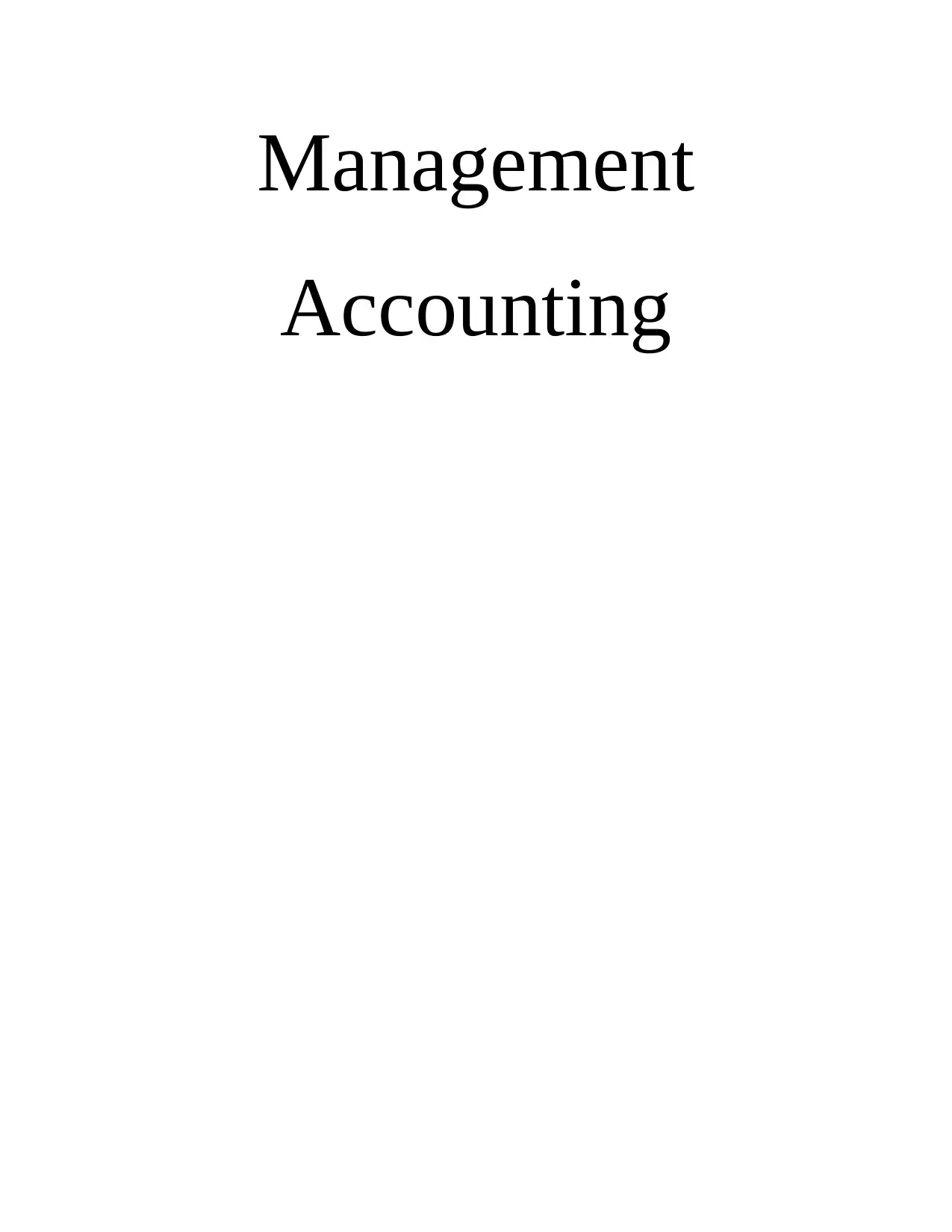
Management
Accounting
Accounting
Secure Best Marks with AI Grader
Need help grading? Try our AI Grader for instant feedback on your assignments.
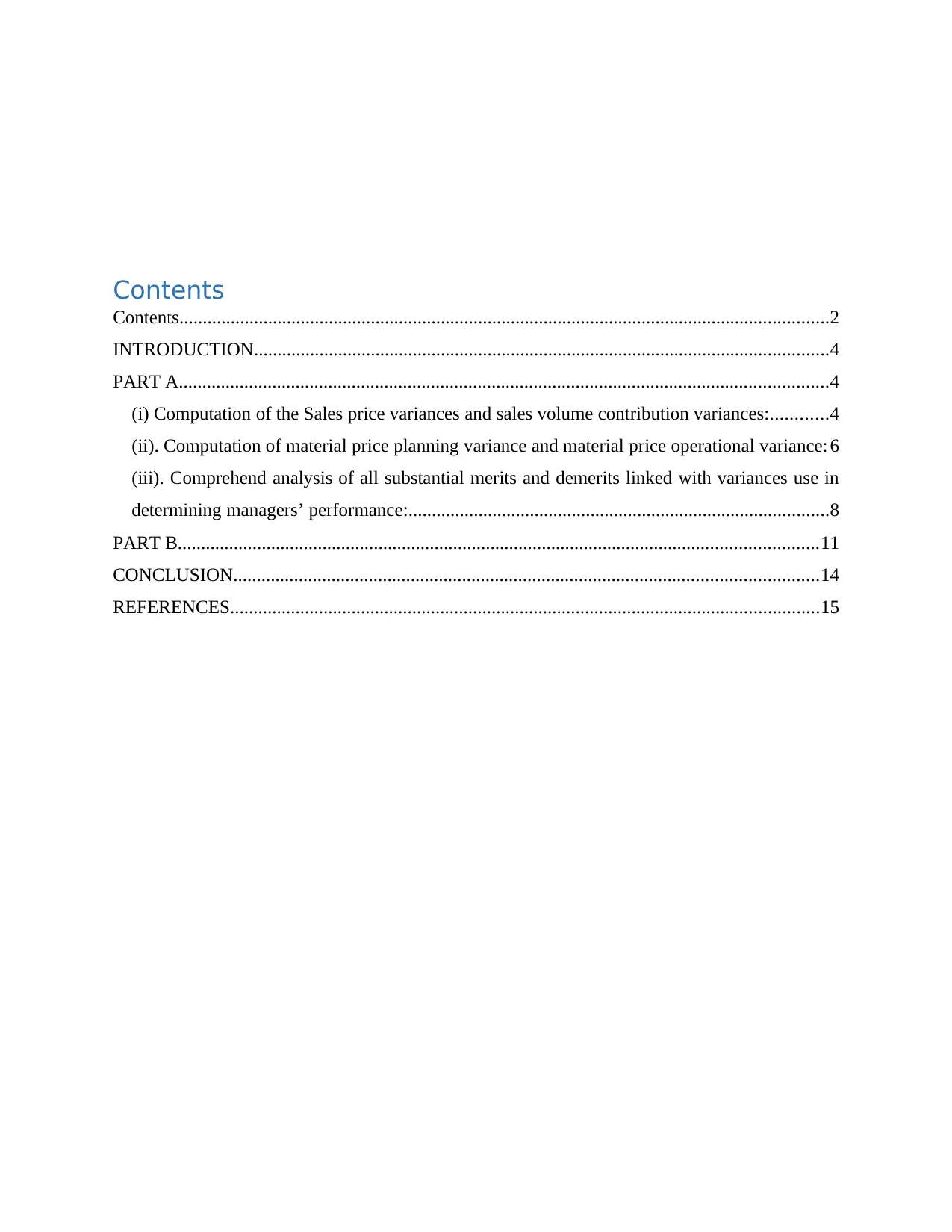
Contents
Contents...........................................................................................................................................2
INTRODUCTION...........................................................................................................................4
PART A...........................................................................................................................................4
(i) Computation of the Sales price variances and sales volume contribution variances:............4
(ii). Computation of material price planning variance and material price operational variance: 6
(iii). Comprehend analysis of all substantial merits and demerits linked with variances use in
determining managers’ performance:..........................................................................................8
PART B.........................................................................................................................................11
CONCLUSION.............................................................................................................................14
REFERENCES..............................................................................................................................15
Contents...........................................................................................................................................2
INTRODUCTION...........................................................................................................................4
PART A...........................................................................................................................................4
(i) Computation of the Sales price variances and sales volume contribution variances:............4
(ii). Computation of material price planning variance and material price operational variance: 6
(iii). Comprehend analysis of all substantial merits and demerits linked with variances use in
determining managers’ performance:..........................................................................................8
PART B.........................................................................................................................................11
CONCLUSION.............................................................................................................................14
REFERENCES..............................................................................................................................15
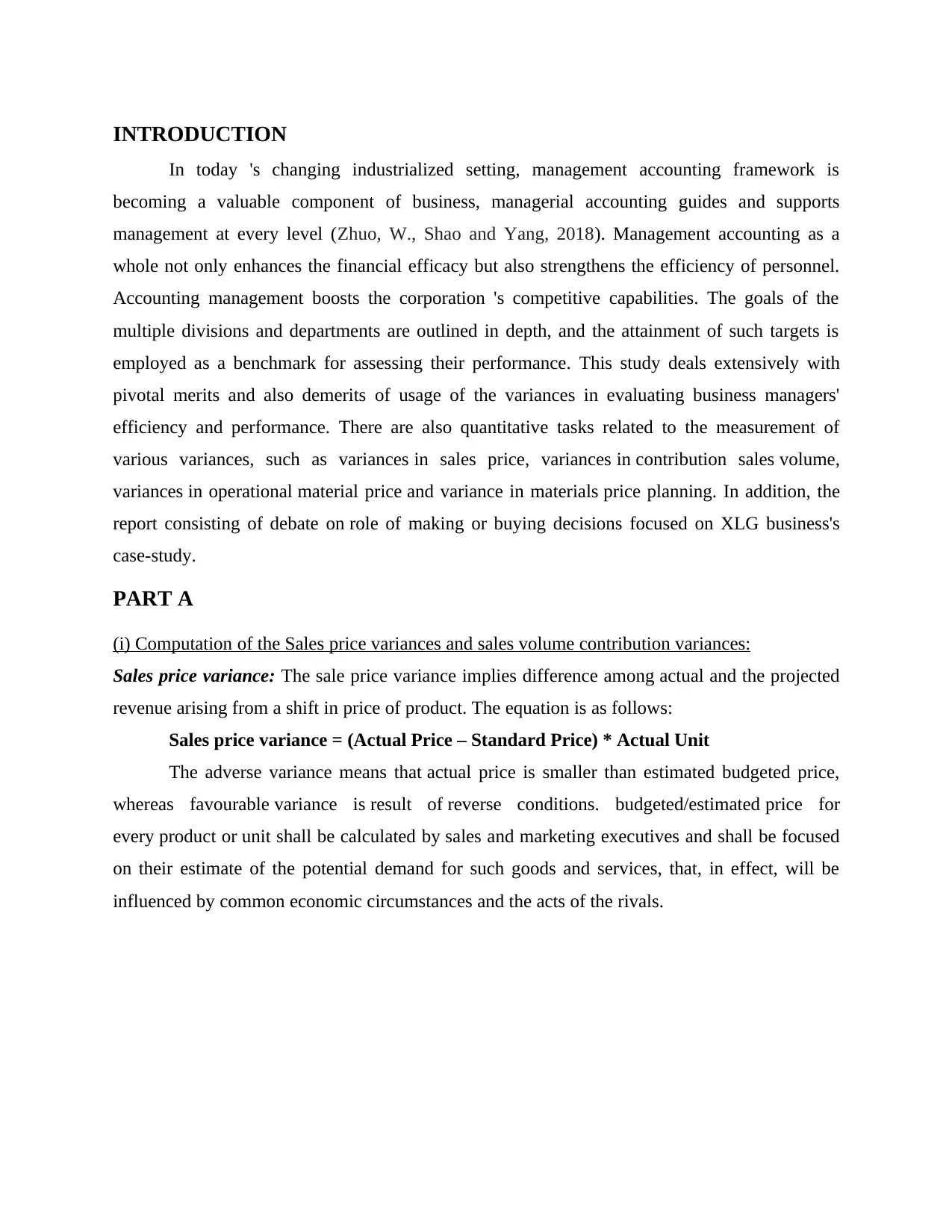
INTRODUCTION
In today 's changing industrialized setting, management accounting framework is
becoming a valuable component of business, managerial accounting guides and supports
management at every level (Zhuo, W., Shao and Yang, 2018). Management accounting as a
whole not only enhances the financial efficacy but also strengthens the efficiency of personnel.
Accounting management boosts the corporation 's competitive capabilities. The goals of the
multiple divisions and departments are outlined in depth, and the attainment of such targets is
employed as a benchmark for assessing their performance. This study deals extensively with
pivotal merits and also demerits of usage of the variances in evaluating business managers'
efficiency and performance. There are also quantitative tasks related to the measurement of
various variances, such as variances in sales price, variances in contribution sales volume,
variances in operational material price and variance in materials price planning. In addition, the
report consisting of debate on role of making or buying decisions focused on XLG business's
case-study.
PART A
(i) Computation of the Sales price variances and sales volume contribution variances:
Sales price variance: The sale price variance implies difference among actual and the projected
revenue arising from a shift in price of product. The equation is as follows:
Sales price variance = (Actual Price – Standard Price) * Actual Unit
The adverse variance means that actual price is smaller than estimated budgeted price,
whereas favourable variance is result of reverse conditions. budgeted/estimated price for
every product or unit shall be calculated by sales and marketing executives and shall be focused
on their estimate of the potential demand for such goods and services, that, in effect, will be
influenced by common economic circumstances and the acts of the rivals.
In today 's changing industrialized setting, management accounting framework is
becoming a valuable component of business, managerial accounting guides and supports
management at every level (Zhuo, W., Shao and Yang, 2018). Management accounting as a
whole not only enhances the financial efficacy but also strengthens the efficiency of personnel.
Accounting management boosts the corporation 's competitive capabilities. The goals of the
multiple divisions and departments are outlined in depth, and the attainment of such targets is
employed as a benchmark for assessing their performance. This study deals extensively with
pivotal merits and also demerits of usage of the variances in evaluating business managers'
efficiency and performance. There are also quantitative tasks related to the measurement of
various variances, such as variances in sales price, variances in contribution sales volume,
variances in operational material price and variance in materials price planning. In addition, the
report consisting of debate on role of making or buying decisions focused on XLG business's
case-study.
PART A
(i) Computation of the Sales price variances and sales volume contribution variances:
Sales price variance: The sale price variance implies difference among actual and the projected
revenue arising from a shift in price of product. The equation is as follows:
Sales price variance = (Actual Price – Standard Price) * Actual Unit
The adverse variance means that actual price is smaller than estimated budgeted price,
whereas favourable variance is result of reverse conditions. budgeted/estimated price for
every product or unit shall be calculated by sales and marketing executives and shall be focused
on their estimate of the potential demand for such goods and services, that, in effect, will be
influenced by common economic circumstances and the acts of the rivals.
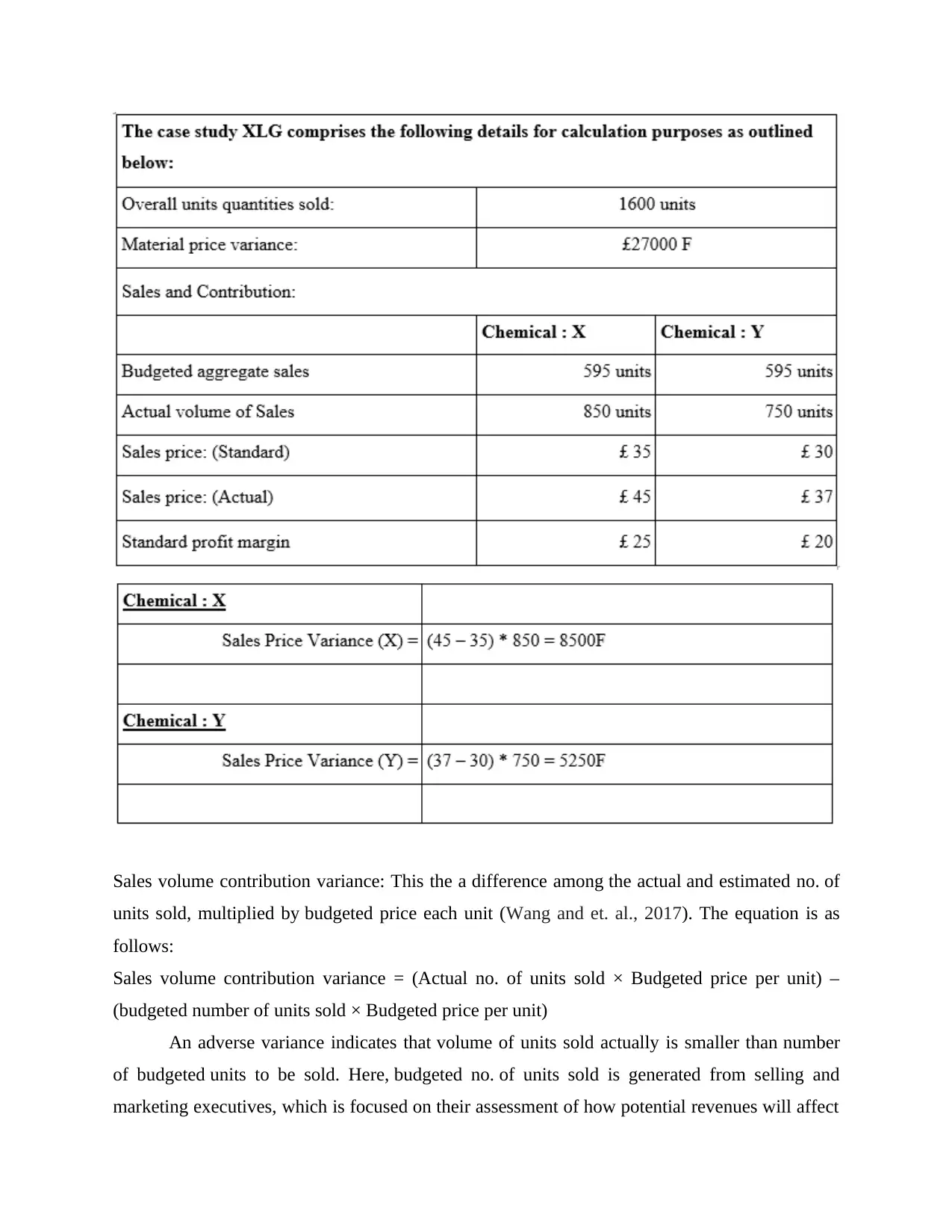
Sales volume contribution variance: This the a difference among the actual and estimated no. of
units sold, multiplied by budgeted price each unit (Wang and et. al., 2017). The equation is as
follows:
Sales volume contribution variance = (Actual no. of units sold × Budgeted price per unit) –
(budgeted number of units sold × Budgeted price per unit)
An adverse variance indicates that volume of units sold actually is smaller than number
of budgeted units to be sold. Here, budgeted no. of units sold is generated from selling and
marketing executives, which is focused on their assessment of how potential revenues will affect
units sold, multiplied by budgeted price each unit (Wang and et. al., 2017). The equation is as
follows:
Sales volume contribution variance = (Actual no. of units sold × Budgeted price per unit) –
(budgeted number of units sold × Budgeted price per unit)
An adverse variance indicates that volume of units sold actually is smaller than number
of budgeted units to be sold. Here, budgeted no. of units sold is generated from selling and
marketing executives, which is focused on their assessment of how potential revenues will affect
Secure Best Marks with AI Grader
Need help grading? Try our AI Grader for instant feedback on your assignments.
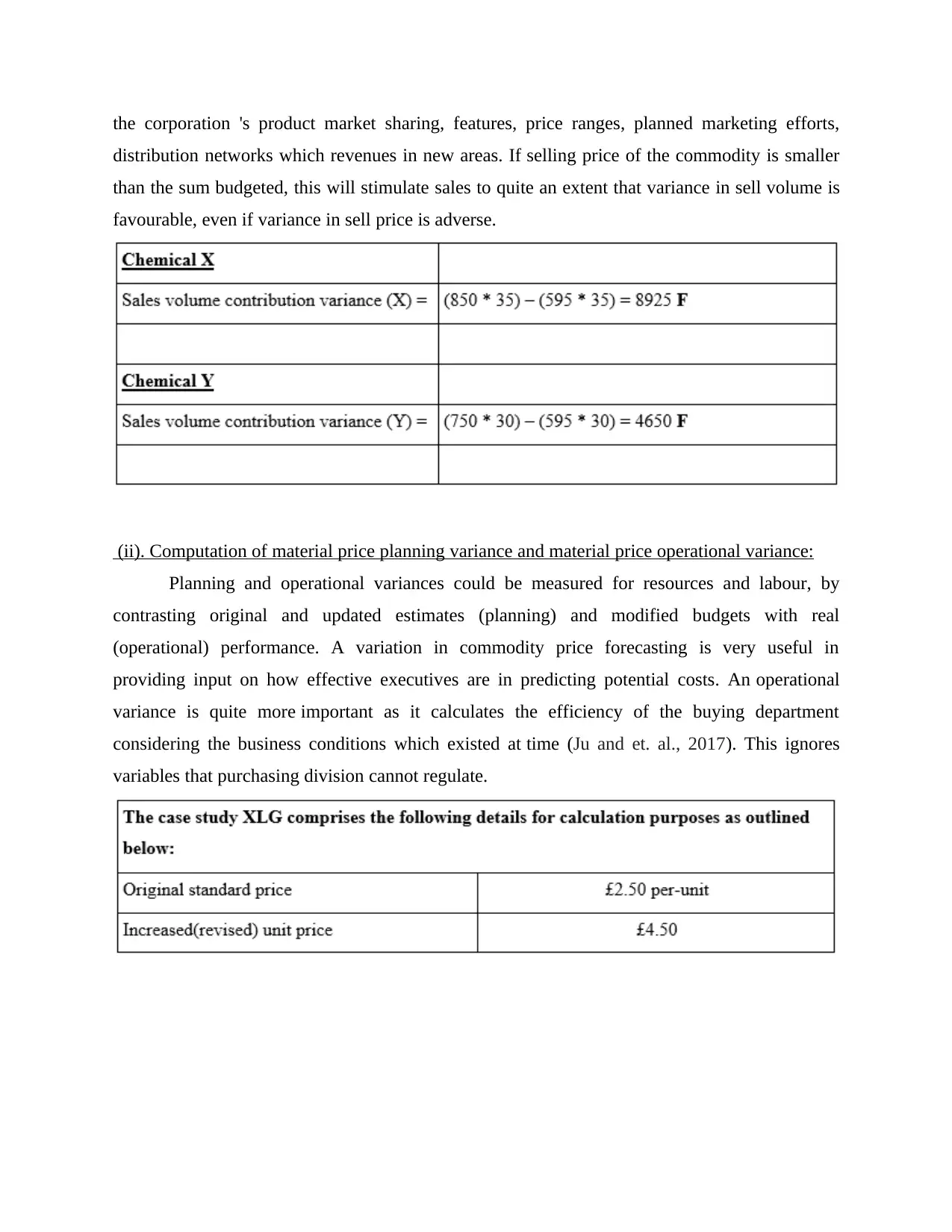
the corporation 's product market sharing, features, price ranges, planned marketing efforts,
distribution networks which revenues in new areas. If selling price of the commodity is smaller
than the sum budgeted, this will stimulate sales to quite an extent that variance in sell volume is
favourable, even if variance in sell price is adverse.
(ii). Computation of material price planning variance and material price operational variance:
Planning and operational variances could be measured for resources and labour, by
contrasting original and updated estimates (planning) and modified budgets with real
(operational) performance. A variation in commodity price forecasting is very useful in
providing input on how effective executives are in predicting potential costs. An operational
variance is quite more important as it calculates the efficiency of the buying department
considering the business conditions which existed at time (Ju and et. al., 2017). This ignores
variables that purchasing division cannot regulate.
distribution networks which revenues in new areas. If selling price of the commodity is smaller
than the sum budgeted, this will stimulate sales to quite an extent that variance in sell volume is
favourable, even if variance in sell price is adverse.
(ii). Computation of material price planning variance and material price operational variance:
Planning and operational variances could be measured for resources and labour, by
contrasting original and updated estimates (planning) and modified budgets with real
(operational) performance. A variation in commodity price forecasting is very useful in
providing input on how effective executives are in predicting potential costs. An operational
variance is quite more important as it calculates the efficiency of the buying department
considering the business conditions which existed at time (Ju and et. al., 2017). This ignores
variables that purchasing division cannot regulate.
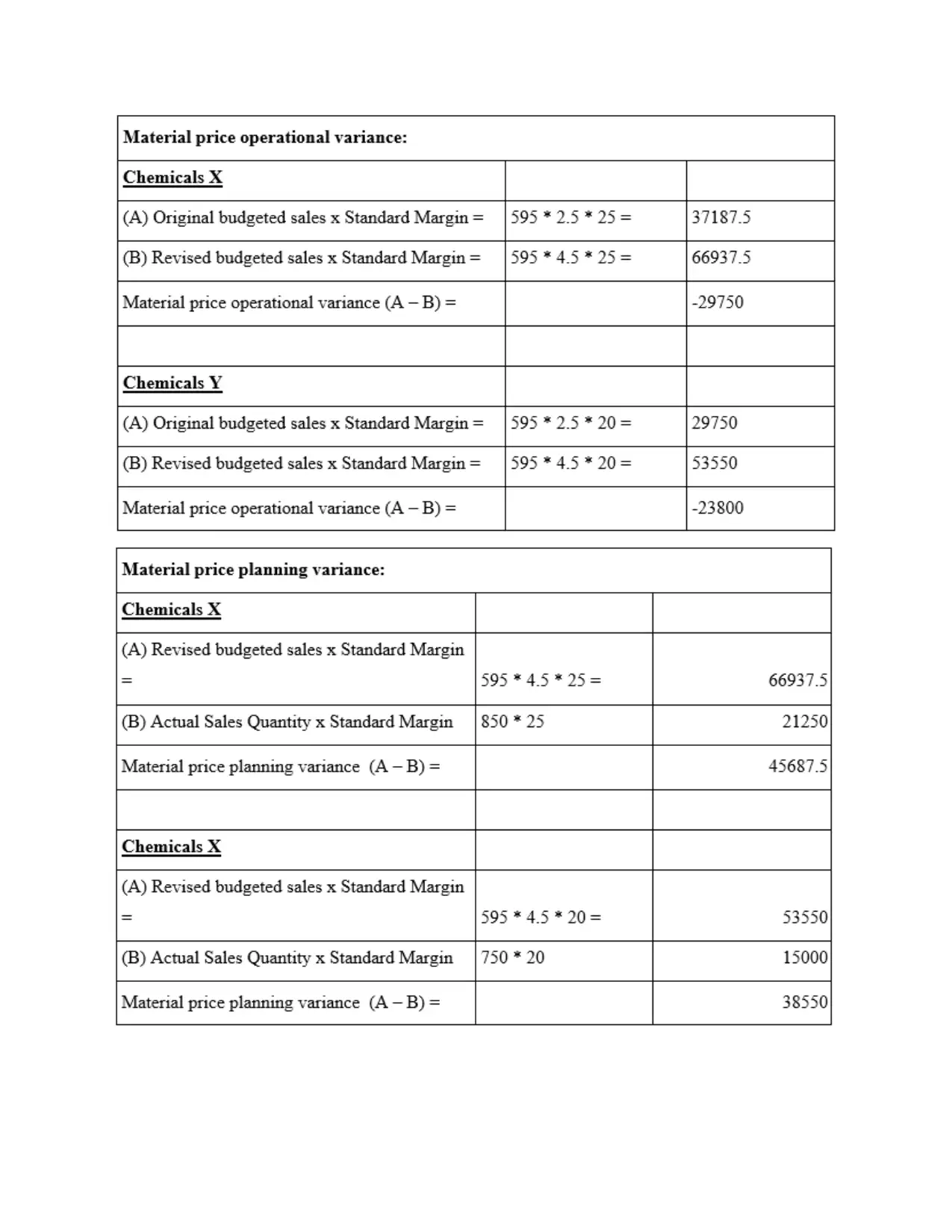
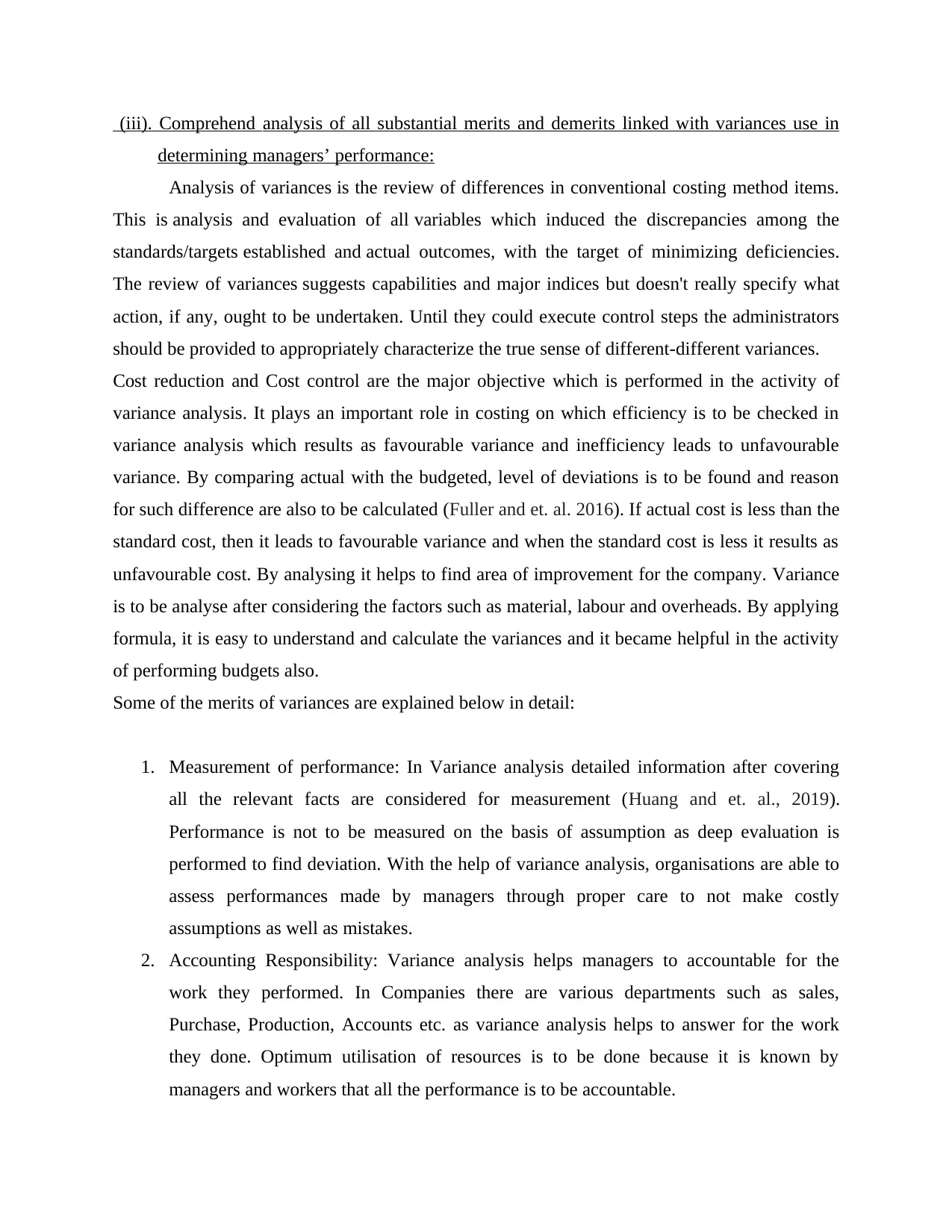
(iii). Comprehend analysis of all substantial merits and demerits linked with variances use in
determining managers’ performance:
Analysis of variances is the review of differences in conventional costing method items.
This is analysis and evaluation of all variables which induced the discrepancies among the
standards/targets established and actual outcomes, with the target of minimizing deficiencies.
The review of variances suggests capabilities and major indices but doesn't really specify what
action, if any, ought to be undertaken. Until they could execute control steps the administrators
should be provided to appropriately characterize the true sense of different-different variances.
Cost reduction and Cost control are the major objective which is performed in the activity of
variance analysis. It plays an important role in costing on which efficiency is to be checked in
variance analysis which results as favourable variance and inefficiency leads to unfavourable
variance. By comparing actual with the budgeted, level of deviations is to be found and reason
for such difference are also to be calculated (Fuller and et. al. 2016). If actual cost is less than the
standard cost, then it leads to favourable variance and when the standard cost is less it results as
unfavourable cost. By analysing it helps to find area of improvement for the company. Variance
is to be analyse after considering the factors such as material, labour and overheads. By applying
formula, it is easy to understand and calculate the variances and it became helpful in the activity
of performing budgets also.
Some of the merits of variances are explained below in detail:
1. Measurement of performance: In Variance analysis detailed information after covering
all the relevant facts are considered for measurement (Huang and et. al., 2019).
Performance is not to be measured on the basis of assumption as deep evaluation is
performed to find deviation. With the help of variance analysis, organisations are able to
assess performances made by managers through proper care to not make costly
assumptions as well as mistakes.
2. Accounting Responsibility: Variance analysis helps managers to accountable for the
work they performed. In Companies there are various departments such as sales,
Purchase, Production, Accounts etc. as variance analysis helps to answer for the work
they done. Optimum utilisation of resources is to be done because it is known by
managers and workers that all the performance is to be accountable.
determining managers’ performance:
Analysis of variances is the review of differences in conventional costing method items.
This is analysis and evaluation of all variables which induced the discrepancies among the
standards/targets established and actual outcomes, with the target of minimizing deficiencies.
The review of variances suggests capabilities and major indices but doesn't really specify what
action, if any, ought to be undertaken. Until they could execute control steps the administrators
should be provided to appropriately characterize the true sense of different-different variances.
Cost reduction and Cost control are the major objective which is performed in the activity of
variance analysis. It plays an important role in costing on which efficiency is to be checked in
variance analysis which results as favourable variance and inefficiency leads to unfavourable
variance. By comparing actual with the budgeted, level of deviations is to be found and reason
for such difference are also to be calculated (Fuller and et. al. 2016). If actual cost is less than the
standard cost, then it leads to favourable variance and when the standard cost is less it results as
unfavourable cost. By analysing it helps to find area of improvement for the company. Variance
is to be analyse after considering the factors such as material, labour and overheads. By applying
formula, it is easy to understand and calculate the variances and it became helpful in the activity
of performing budgets also.
Some of the merits of variances are explained below in detail:
1. Measurement of performance: In Variance analysis detailed information after covering
all the relevant facts are considered for measurement (Huang and et. al., 2019).
Performance is not to be measured on the basis of assumption as deep evaluation is
performed to find deviation. With the help of variance analysis, organisations are able to
assess performances made by managers through proper care to not make costly
assumptions as well as mistakes.
2. Accounting Responsibility: Variance analysis helps managers to accountable for the
work they performed. In Companies there are various departments such as sales,
Purchase, Production, Accounts etc. as variance analysis helps to answer for the work
they done. Optimum utilisation of resources is to be done because it is known by
managers and workers that all the performance is to be accountable.
Paraphrase This Document
Need a fresh take? Get an instant paraphrase of this document with our AI Paraphraser
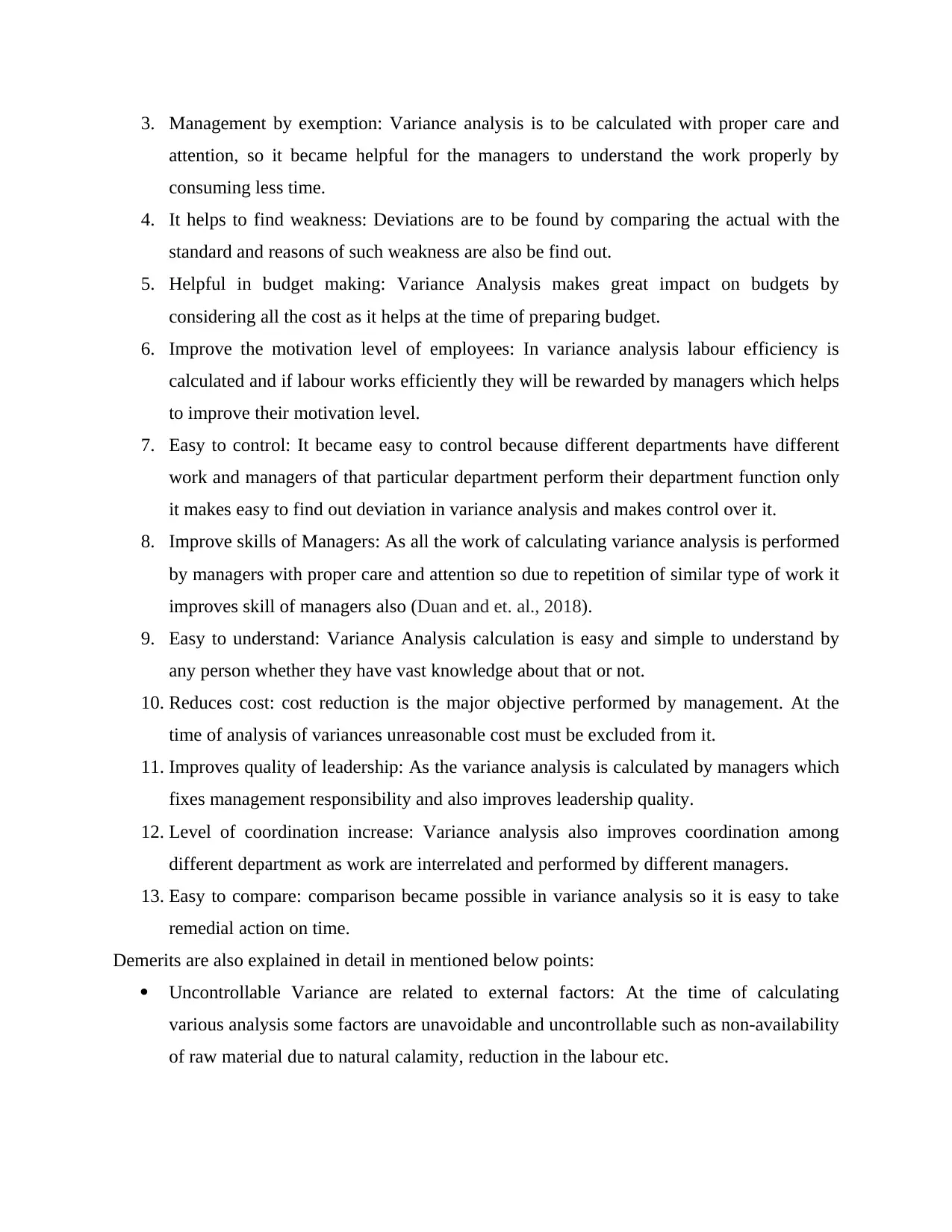
3. Management by exemption: Variance analysis is to be calculated with proper care and
attention, so it became helpful for the managers to understand the work properly by
consuming less time.
4. It helps to find weakness: Deviations are to be found by comparing the actual with the
standard and reasons of such weakness are also be find out.
5. Helpful in budget making: Variance Analysis makes great impact on budgets by
considering all the cost as it helps at the time of preparing budget.
6. Improve the motivation level of employees: In variance analysis labour efficiency is
calculated and if labour works efficiently they will be rewarded by managers which helps
to improve their motivation level.
7. Easy to control: It became easy to control because different departments have different
work and managers of that particular department perform their department function only
it makes easy to find out deviation in variance analysis and makes control over it.
8. Improve skills of Managers: As all the work of calculating variance analysis is performed
by managers with proper care and attention so due to repetition of similar type of work it
improves skill of managers also (Duan and et. al., 2018).
9. Easy to understand: Variance Analysis calculation is easy and simple to understand by
any person whether they have vast knowledge about that or not.
10. Reduces cost: cost reduction is the major objective performed by management. At the
time of analysis of variances unreasonable cost must be excluded from it.
11. Improves quality of leadership: As the variance analysis is calculated by managers which
fixes management responsibility and also improves leadership quality.
12. Level of coordination increase: Variance analysis also improves coordination among
different department as work are interrelated and performed by different managers.
13. Easy to compare: comparison became possible in variance analysis so it is easy to take
remedial action on time.
Demerits are also explained in detail in mentioned below points:
Uncontrollable Variance are related to external factors: At the time of calculating
various analysis some factors are unavoidable and uncontrollable such as non-availability
of raw material due to natural calamity, reduction in the labour etc.
attention, so it became helpful for the managers to understand the work properly by
consuming less time.
4. It helps to find weakness: Deviations are to be found by comparing the actual with the
standard and reasons of such weakness are also be find out.
5. Helpful in budget making: Variance Analysis makes great impact on budgets by
considering all the cost as it helps at the time of preparing budget.
6. Improve the motivation level of employees: In variance analysis labour efficiency is
calculated and if labour works efficiently they will be rewarded by managers which helps
to improve their motivation level.
7. Easy to control: It became easy to control because different departments have different
work and managers of that particular department perform their department function only
it makes easy to find out deviation in variance analysis and makes control over it.
8. Improve skills of Managers: As all the work of calculating variance analysis is performed
by managers with proper care and attention so due to repetition of similar type of work it
improves skill of managers also (Duan and et. al., 2018).
9. Easy to understand: Variance Analysis calculation is easy and simple to understand by
any person whether they have vast knowledge about that or not.
10. Reduces cost: cost reduction is the major objective performed by management. At the
time of analysis of variances unreasonable cost must be excluded from it.
11. Improves quality of leadership: As the variance analysis is calculated by managers which
fixes management responsibility and also improves leadership quality.
12. Level of coordination increase: Variance analysis also improves coordination among
different department as work are interrelated and performed by different managers.
13. Easy to compare: comparison became possible in variance analysis so it is easy to take
remedial action on time.
Demerits are also explained in detail in mentioned below points:
Uncontrollable Variance are related to external factors: At the time of calculating
various analysis some factors are unavoidable and uncontrollable such as non-availability
of raw material due to natural calamity, reduction in the labour etc.
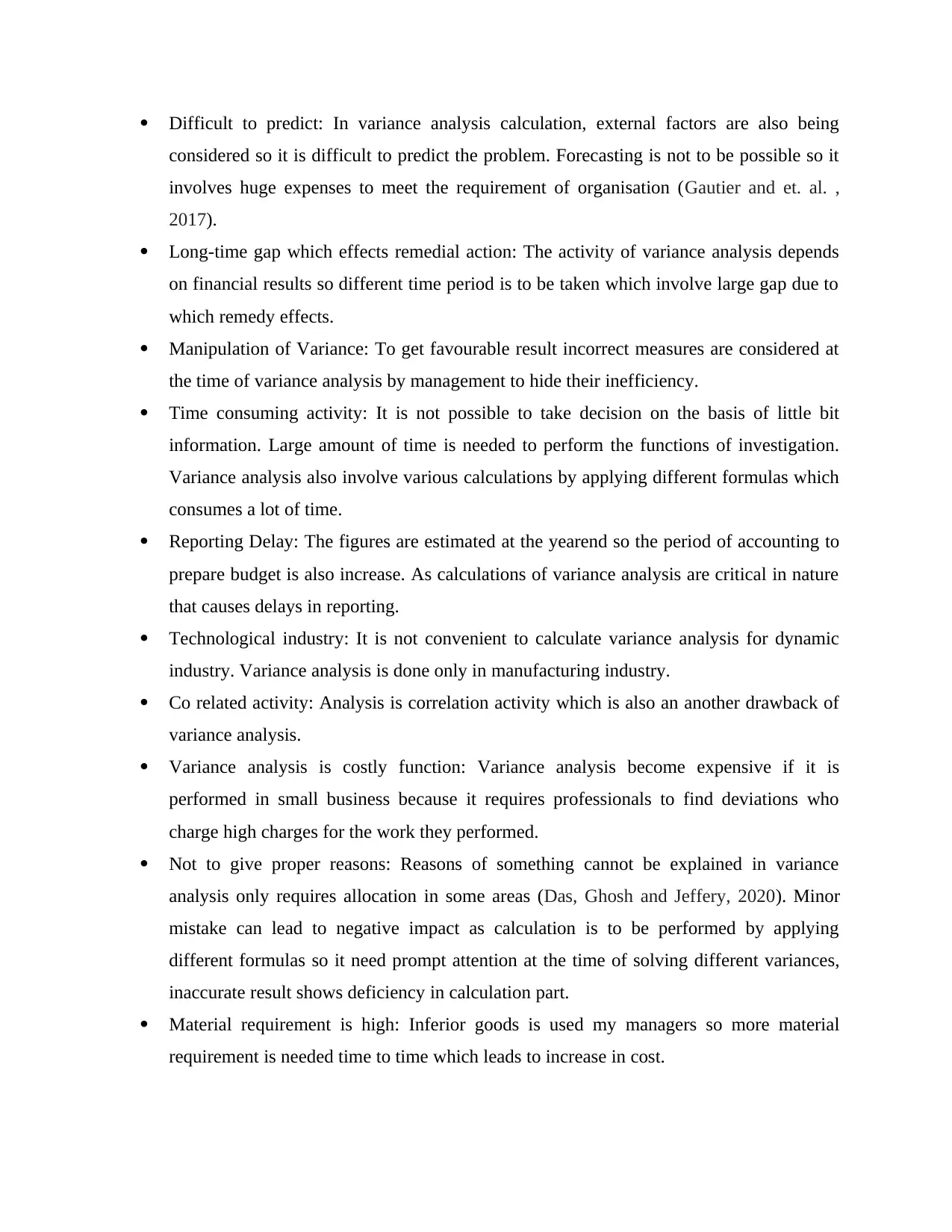
Difficult to predict: In variance analysis calculation, external factors are also being
considered so it is difficult to predict the problem. Forecasting is not to be possible so it
involves huge expenses to meet the requirement of organisation (Gautier and et. al. ,
2017).
Long-time gap which effects remedial action: The activity of variance analysis depends
on financial results so different time period is to be taken which involve large gap due to
which remedy effects.
Manipulation of Variance: To get favourable result incorrect measures are considered at
the time of variance analysis by management to hide their inefficiency.
Time consuming activity: It is not possible to take decision on the basis of little bit
information. Large amount of time is needed to perform the functions of investigation.
Variance analysis also involve various calculations by applying different formulas which
consumes a lot of time.
Reporting Delay: The figures are estimated at the yearend so the period of accounting to
prepare budget is also increase. As calculations of variance analysis are critical in nature
that causes delays in reporting.
Technological industry: It is not convenient to calculate variance analysis for dynamic
industry. Variance analysis is done only in manufacturing industry.
Co related activity: Analysis is correlation activity which is also an another drawback of
variance analysis.
Variance analysis is costly function: Variance analysis become expensive if it is
performed in small business because it requires professionals to find deviations who
charge high charges for the work they performed.
Not to give proper reasons: Reasons of something cannot be explained in variance
analysis only requires allocation in some areas (Das, Ghosh and Jeffery, 2020). Minor
mistake can lead to negative impact as calculation is to be performed by applying
different formulas so it need prompt attention at the time of solving different variances,
inaccurate result shows deficiency in calculation part.
Material requirement is high: Inferior goods is used my managers so more material
requirement is needed time to time which leads to increase in cost.
considered so it is difficult to predict the problem. Forecasting is not to be possible so it
involves huge expenses to meet the requirement of organisation (Gautier and et. al. ,
2017).
Long-time gap which effects remedial action: The activity of variance analysis depends
on financial results so different time period is to be taken which involve large gap due to
which remedy effects.
Manipulation of Variance: To get favourable result incorrect measures are considered at
the time of variance analysis by management to hide their inefficiency.
Time consuming activity: It is not possible to take decision on the basis of little bit
information. Large amount of time is needed to perform the functions of investigation.
Variance analysis also involve various calculations by applying different formulas which
consumes a lot of time.
Reporting Delay: The figures are estimated at the yearend so the period of accounting to
prepare budget is also increase. As calculations of variance analysis are critical in nature
that causes delays in reporting.
Technological industry: It is not convenient to calculate variance analysis for dynamic
industry. Variance analysis is done only in manufacturing industry.
Co related activity: Analysis is correlation activity which is also an another drawback of
variance analysis.
Variance analysis is costly function: Variance analysis become expensive if it is
performed in small business because it requires professionals to find deviations who
charge high charges for the work they performed.
Not to give proper reasons: Reasons of something cannot be explained in variance
analysis only requires allocation in some areas (Das, Ghosh and Jeffery, 2020). Minor
mistake can lead to negative impact as calculation is to be performed by applying
different formulas so it need prompt attention at the time of solving different variances,
inaccurate result shows deficiency in calculation part.
Material requirement is high: Inferior goods is used my managers so more material
requirement is needed time to time which leads to increase in cost.
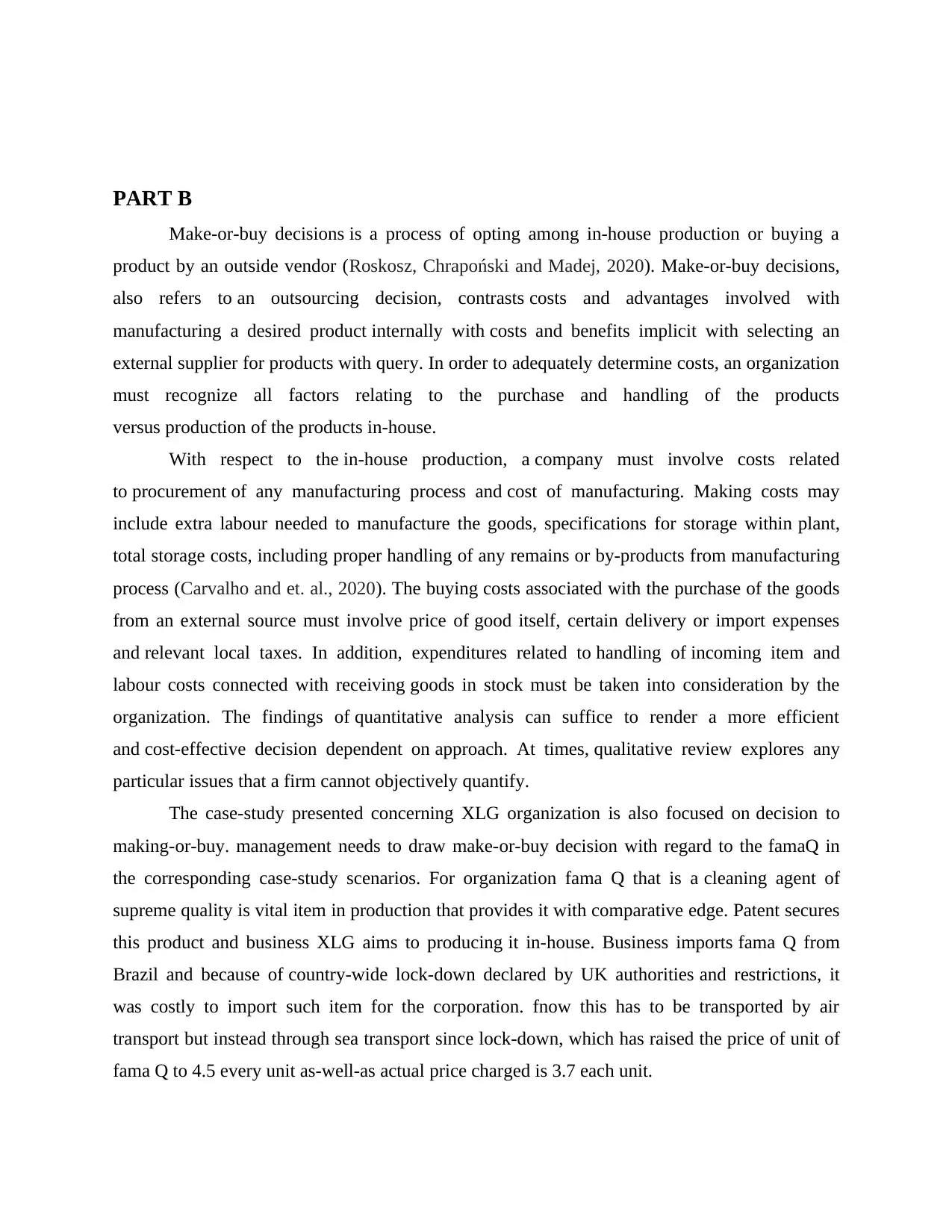
PART B
Make-or-buy decisions is a process of opting among in-house production or buying a
product by an outside vendor (Roskosz, Chrapoński and Madej, 2020). Make-or-buy decisions,
also refers to an outsourcing decision, contrasts costs and advantages involved with
manufacturing a desired product internally with costs and benefits implicit with selecting an
external supplier for products with query. In order to adequately determine costs, an organization
must recognize all factors relating to the purchase and handling of the products
versus production of the products in-house.
With respect to the in-house production, a company must involve costs related
to procurement of any manufacturing process and cost of manufacturing. Making costs may
include extra labour needed to manufacture the goods, specifications for storage within plant,
total storage costs, including proper handling of any remains or by-products from manufacturing
process (Carvalho and et. al., 2020). The buying costs associated with the purchase of the goods
from an external source must involve price of good itself, certain delivery or import expenses
and relevant local taxes. In addition, expenditures related to handling of incoming item and
labour costs connected with receiving goods in stock must be taken into consideration by the
organization. The findings of quantitative analysis can suffice to render a more efficient
and cost-effective decision dependent on approach. At times, qualitative review explores any
particular issues that a firm cannot objectively quantify.
The case-study presented concerning XLG organization is also focused on decision to
making-or-buy. management needs to draw make-or-buy decision with regard to the famaQ in
the corresponding case-study scenarios. For organization fama Q that is a cleaning agent of
supreme quality is vital item in production that provides it with comparative edge. Patent secures
this product and business XLG aims to producing it in-house. Business imports fama Q from
Brazil and because of country-wide lock-down declared by UK authorities and restrictions, it
was costly to import such item for the corporation. fnow this has to be transported by air
transport but instead through sea transport since lock-down, which has raised the price of unit of
fama Q to 4.5 every unit as-well-as actual price charged is 3.7 each unit.
Make-or-buy decisions is a process of opting among in-house production or buying a
product by an outside vendor (Roskosz, Chrapoński and Madej, 2020). Make-or-buy decisions,
also refers to an outsourcing decision, contrasts costs and advantages involved with
manufacturing a desired product internally with costs and benefits implicit with selecting an
external supplier for products with query. In order to adequately determine costs, an organization
must recognize all factors relating to the purchase and handling of the products
versus production of the products in-house.
With respect to the in-house production, a company must involve costs related
to procurement of any manufacturing process and cost of manufacturing. Making costs may
include extra labour needed to manufacture the goods, specifications for storage within plant,
total storage costs, including proper handling of any remains or by-products from manufacturing
process (Carvalho and et. al., 2020). The buying costs associated with the purchase of the goods
from an external source must involve price of good itself, certain delivery or import expenses
and relevant local taxes. In addition, expenditures related to handling of incoming item and
labour costs connected with receiving goods in stock must be taken into consideration by the
organization. The findings of quantitative analysis can suffice to render a more efficient
and cost-effective decision dependent on approach. At times, qualitative review explores any
particular issues that a firm cannot objectively quantify.
The case-study presented concerning XLG organization is also focused on decision to
making-or-buy. management needs to draw make-or-buy decision with regard to the famaQ in
the corresponding case-study scenarios. For organization fama Q that is a cleaning agent of
supreme quality is vital item in production that provides it with comparative edge. Patent secures
this product and business XLG aims to producing it in-house. Business imports fama Q from
Brazil and because of country-wide lock-down declared by UK authorities and restrictions, it
was costly to import such item for the corporation. fnow this has to be transported by air
transport but instead through sea transport since lock-down, which has raised the price of unit of
fama Q to 4.5 every unit as-well-as actual price charged is 3.7 each unit.
Secure Best Marks with AI Grader
Need help grading? Try our AI Grader for instant feedback on your assignments.
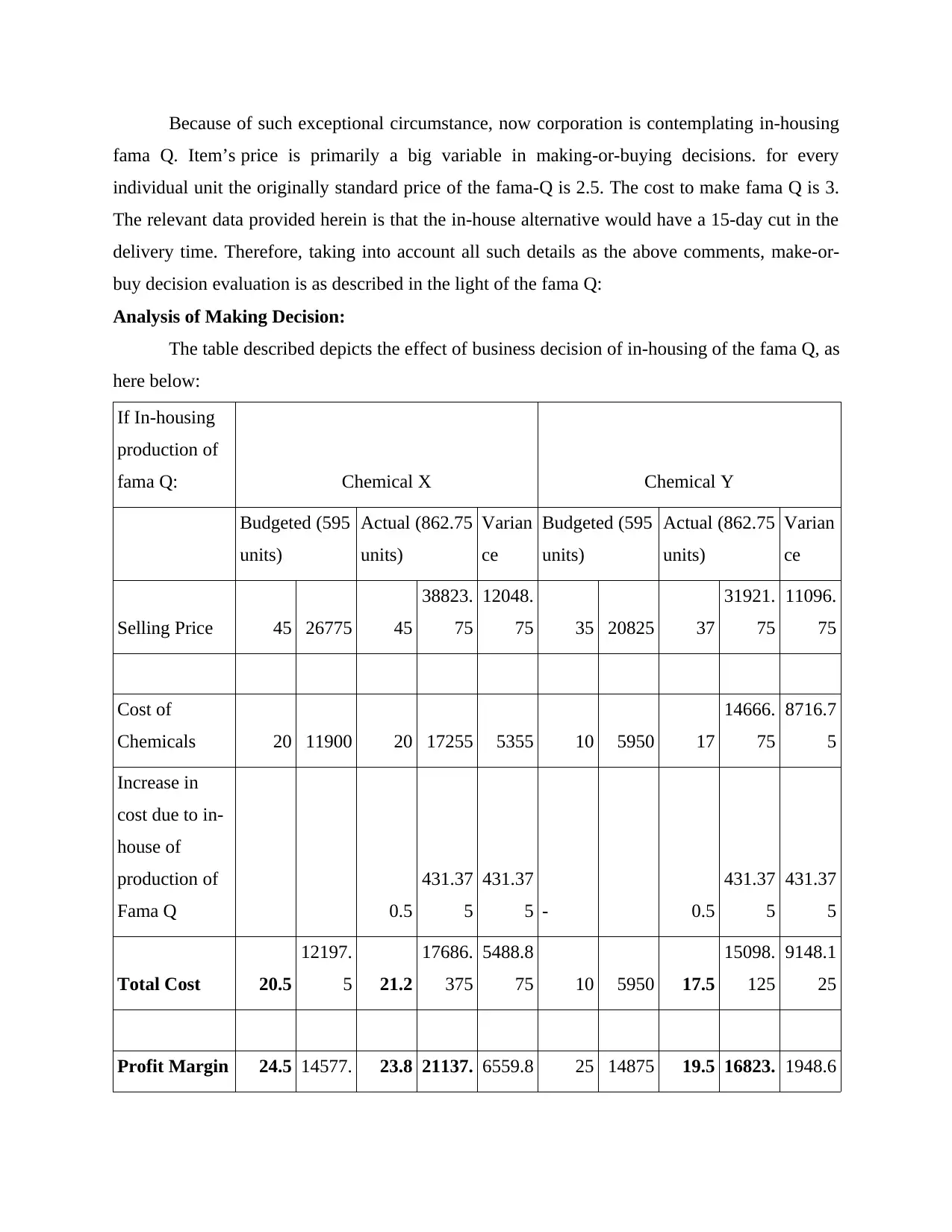
Because of such exceptional circumstance, now corporation is contemplating in-housing
fama Q. Item’s price is primarily a big variable in making-or-buying decisions. for every
individual unit the originally standard price of the fama-Q is 2.5. The cost to make fama Q is 3.
The relevant data provided herein is that the in-house alternative would have a 15-day cut in the
delivery time. Therefore, taking into account all such details as the above comments, make-or-
buy decision evaluation is as described in the light of the fama Q:
Analysis of Making Decision:
The table described depicts the effect of business decision of in-housing of the fama Q, as
here below:
If In-housing
production of
fama Q: Chemical X Chemical Y
Budgeted (595
units)
Actual (862.75
units)
Varian
ce
Budgeted (595
units)
Actual (862.75
units)
Varian
ce
Selling Price 45 26775 45
38823.
75
12048.
75 35 20825 37
31921.
75
11096.
75
Cost of
Chemicals 20 11900 20 17255 5355 10 5950 17
14666.
75
8716.7
5
Increase in
cost due to in-
house of
production of
Fama Q 0.5
431.37
5
431.37
5 - 0.5
431.37
5
431.37
5
Total Cost 20.5
12197.
5 21.2
17686.
375
5488.8
75 10 5950 17.5
15098.
125
9148.1
25
Profit Margin 24.5 14577. 23.8 21137. 6559.8 25 14875 19.5 16823. 1948.6
fama Q. Item’s price is primarily a big variable in making-or-buying decisions. for every
individual unit the originally standard price of the fama-Q is 2.5. The cost to make fama Q is 3.
The relevant data provided herein is that the in-house alternative would have a 15-day cut in the
delivery time. Therefore, taking into account all such details as the above comments, make-or-
buy decision evaluation is as described in the light of the fama Q:
Analysis of Making Decision:
The table described depicts the effect of business decision of in-housing of the fama Q, as
here below:
If In-housing
production of
fama Q: Chemical X Chemical Y
Budgeted (595
units)
Actual (862.75
units)
Varian
ce
Budgeted (595
units)
Actual (862.75
units)
Varian
ce
Selling Price 45 26775 45
38823.
75
12048.
75 35 20825 37
31921.
75
11096.
75
Cost of
Chemicals 20 11900 20 17255 5355 10 5950 17
14666.
75
8716.7
5
Increase in
cost due to in-
house of
production of
Fama Q 0.5
431.37
5
431.37
5 - 0.5
431.37
5
431.37
5
Total Cost 20.5
12197.
5 21.2
17686.
375
5488.8
75 10 5950 17.5
15098.
125
9148.1
25
Profit Margin 24.5 14577. 23.8 21137. 6559.8 25 14875 19.5 16823. 1948.6
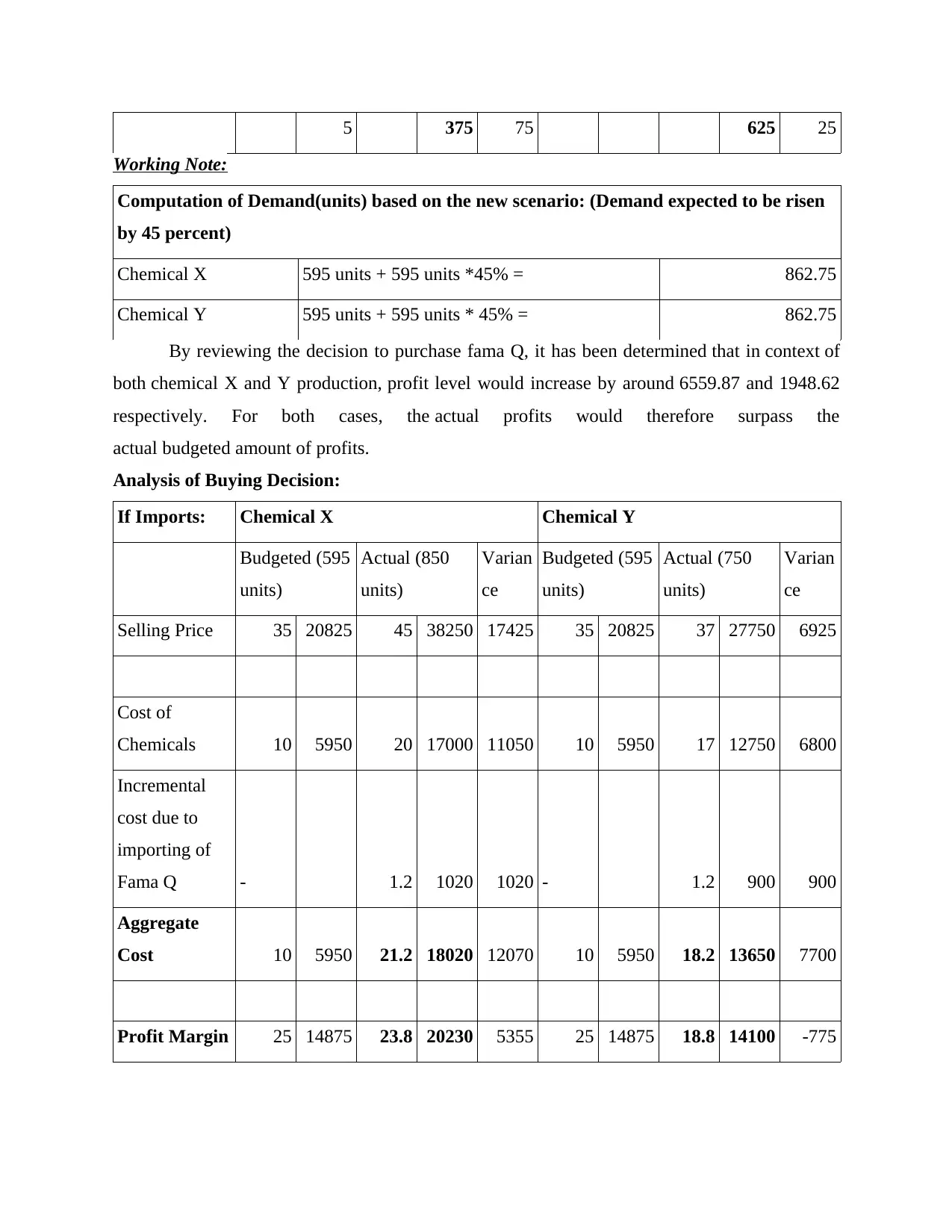
5 375 75 625 25
Working Note:
Computation of Demand(units) based on the new scenario: (Demand expected to be risen
by 45 percent)
Chemical X 595 units + 595 units *45% = 862.75
Chemical Y 595 units + 595 units * 45% = 862.75
By reviewing the decision to purchase fama Q, it has been determined that in context of
both chemical X and Y production, profit level would increase by around 6559.87 and 1948.62
respectively. For both cases, the actual profits would therefore surpass the
actual budgeted amount of profits.
Analysis of Buying Decision:
If Imports: Chemical X Chemical Y
Budgeted (595
units)
Actual (850
units)
Varian
ce
Budgeted (595
units)
Actual (750
units)
Varian
ce
Selling Price 35 20825 45 38250 17425 35 20825 37 27750 6925
Cost of
Chemicals 10 5950 20 17000 11050 10 5950 17 12750 6800
Incremental
cost due to
importing of
Fama Q - 1.2 1020 1020 - 1.2 900 900
Aggregate
Cost 10 5950 21.2 18020 12070 10 5950 18.2 13650 7700
Profit Margin 25 14875 23.8 20230 5355 25 14875 18.8 14100 -775
Working Note:
Computation of Demand(units) based on the new scenario: (Demand expected to be risen
by 45 percent)
Chemical X 595 units + 595 units *45% = 862.75
Chemical Y 595 units + 595 units * 45% = 862.75
By reviewing the decision to purchase fama Q, it has been determined that in context of
both chemical X and Y production, profit level would increase by around 6559.87 and 1948.62
respectively. For both cases, the actual profits would therefore surpass the
actual budgeted amount of profits.
Analysis of Buying Decision:
If Imports: Chemical X Chemical Y
Budgeted (595
units)
Actual (850
units)
Varian
ce
Budgeted (595
units)
Actual (750
units)
Varian
ce
Selling Price 35 20825 45 38250 17425 35 20825 37 27750 6925
Cost of
Chemicals 10 5950 20 17000 11050 10 5950 17 12750 6800
Incremental
cost due to
importing of
Fama Q - 1.2 1020 1020 - 1.2 900 900
Aggregate
Cost 10 5950 21.2 18020 12070 10 5950 18.2 13650 7700
Profit Margin 25 14875 23.8 20230 5355 25 14875 18.8 14100 -775
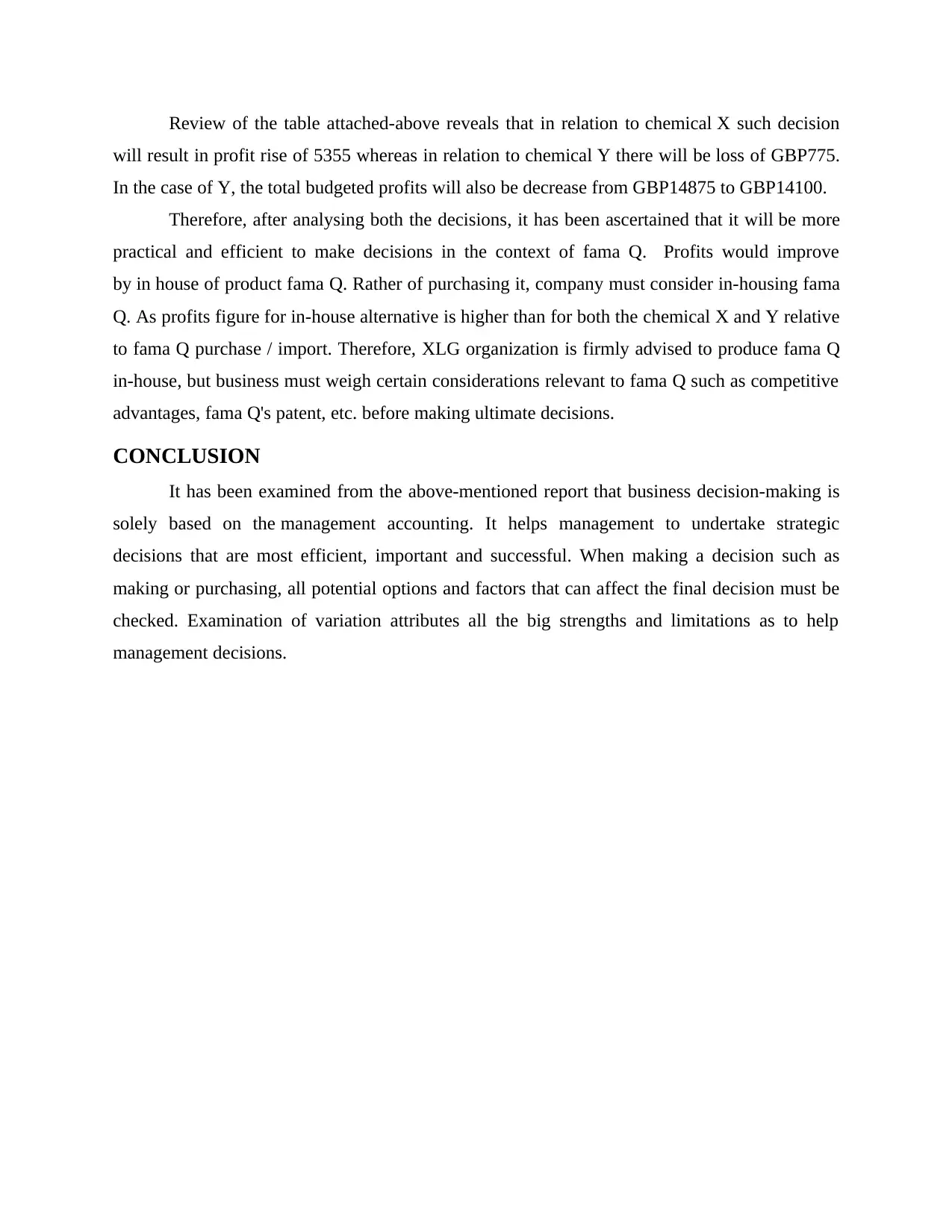
Review of the table attached-above reveals that in relation to chemical X such decision
will result in profit rise of 5355 whereas in relation to chemical Y there will be loss of GBP775.
In the case of Y, the total budgeted profits will also be decrease from GBP14875 to GBP14100.
Therefore, after analysing both the decisions, it has been ascertained that it will be more
practical and efficient to make decisions in the context of fama Q. Profits would improve
by in house of product fama Q. Rather of purchasing it, company must consider in-housing fama
Q. As profits figure for in-house alternative is higher than for both the chemical X and Y relative
to fama Q purchase / import. Therefore, XLG organization is firmly advised to produce fama Q
in-house, but business must weigh certain considerations relevant to fama Q such as competitive
advantages, fama Q's patent, etc. before making ultimate decisions.
CONCLUSION
It has been examined from the above-mentioned report that business decision-making is
solely based on the management accounting. It helps management to undertake strategic
decisions that are most efficient, important and successful. When making a decision such as
making or purchasing, all potential options and factors that can affect the final decision must be
checked. Examination of variation attributes all the big strengths and limitations as to help
management decisions.
will result in profit rise of 5355 whereas in relation to chemical Y there will be loss of GBP775.
In the case of Y, the total budgeted profits will also be decrease from GBP14875 to GBP14100.
Therefore, after analysing both the decisions, it has been ascertained that it will be more
practical and efficient to make decisions in the context of fama Q. Profits would improve
by in house of product fama Q. Rather of purchasing it, company must consider in-housing fama
Q. As profits figure for in-house alternative is higher than for both the chemical X and Y relative
to fama Q purchase / import. Therefore, XLG organization is firmly advised to produce fama Q
in-house, but business must weigh certain considerations relevant to fama Q such as competitive
advantages, fama Q's patent, etc. before making ultimate decisions.
CONCLUSION
It has been examined from the above-mentioned report that business decision-making is
solely based on the management accounting. It helps management to undertake strategic
decisions that are most efficient, important and successful. When making a decision such as
making or purchasing, all potential options and factors that can affect the final decision must be
checked. Examination of variation attributes all the big strengths and limitations as to help
management decisions.
Paraphrase This Document
Need a fresh take? Get an instant paraphrase of this document with our AI Paraphraser
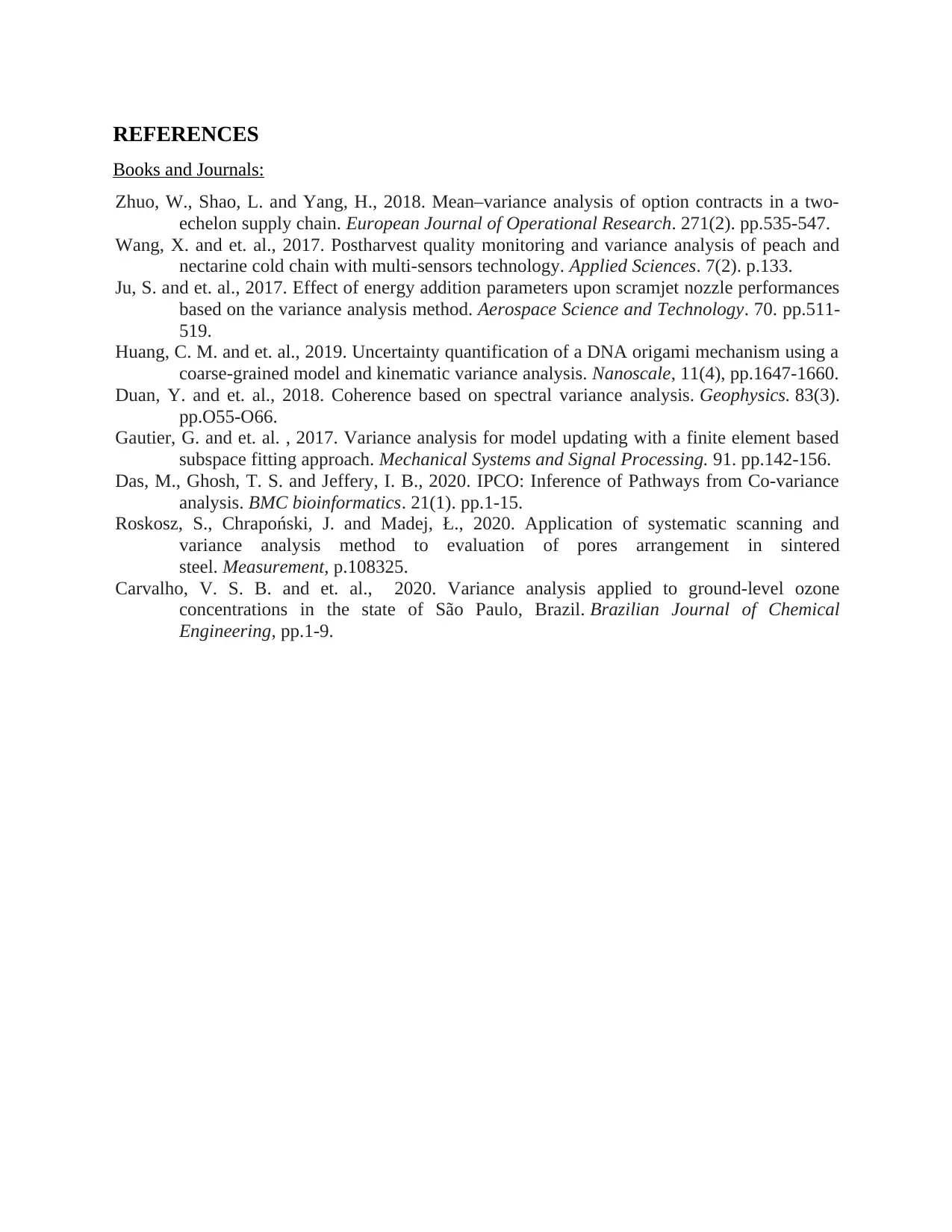
REFERENCES
Books and Journals:
Zhuo, W., Shao, L. and Yang, H., 2018. Mean–variance analysis of option contracts in a two-
echelon supply chain. European Journal of Operational Research. 271(2). pp.535-547.
Wang, X. and et. al., 2017. Postharvest quality monitoring and variance analysis of peach and
nectarine cold chain with multi-sensors technology. Applied Sciences. 7(2). p.133.
Ju, S. and et. al., 2017. Effect of energy addition parameters upon scramjet nozzle performances
based on the variance analysis method. Aerospace Science and Technology. 70. pp.511-
519.
Huang, C. M. and et. al., 2019. Uncertainty quantification of a DNA origami mechanism using a
coarse-grained model and kinematic variance analysis. Nanoscale, 11(4), pp.1647-1660.
Duan, Y. and et. al., 2018. Coherence based on spectral variance analysis. Geophysics. 83(3).
pp.O55-O66.
Gautier, G. and et. al. , 2017. Variance analysis for model updating with a finite element based
subspace fitting approach. Mechanical Systems and Signal Processing. 91. pp.142-156.
Das, M., Ghosh, T. S. and Jeffery, I. B., 2020. IPCO: Inference of Pathways from Co-variance
analysis. BMC bioinformatics. 21(1). pp.1-15.
Roskosz, S., Chrapoński, J. and Madej, Ł., 2020. Application of systematic scanning and
variance analysis method to evaluation of pores arrangement in sintered
steel. Measurement, p.108325.
Carvalho, V. S. B. and et. al., 2020. Variance analysis applied to ground-level ozone
concentrations in the state of São Paulo, Brazil. Brazilian Journal of Chemical
Engineering, pp.1-9.
Books and Journals:
Zhuo, W., Shao, L. and Yang, H., 2018. Mean–variance analysis of option contracts in a two-
echelon supply chain. European Journal of Operational Research. 271(2). pp.535-547.
Wang, X. and et. al., 2017. Postharvest quality monitoring and variance analysis of peach and
nectarine cold chain with multi-sensors technology. Applied Sciences. 7(2). p.133.
Ju, S. and et. al., 2017. Effect of energy addition parameters upon scramjet nozzle performances
based on the variance analysis method. Aerospace Science and Technology. 70. pp.511-
519.
Huang, C. M. and et. al., 2019. Uncertainty quantification of a DNA origami mechanism using a
coarse-grained model and kinematic variance analysis. Nanoscale, 11(4), pp.1647-1660.
Duan, Y. and et. al., 2018. Coherence based on spectral variance analysis. Geophysics. 83(3).
pp.O55-O66.
Gautier, G. and et. al. , 2017. Variance analysis for model updating with a finite element based
subspace fitting approach. Mechanical Systems and Signal Processing. 91. pp.142-156.
Das, M., Ghosh, T. S. and Jeffery, I. B., 2020. IPCO: Inference of Pathways from Co-variance
analysis. BMC bioinformatics. 21(1). pp.1-15.
Roskosz, S., Chrapoński, J. and Madej, Ł., 2020. Application of systematic scanning and
variance analysis method to evaluation of pores arrangement in sintered
steel. Measurement, p.108325.
Carvalho, V. S. B. and et. al., 2020. Variance analysis applied to ground-level ozone
concentrations in the state of São Paulo, Brazil. Brazilian Journal of Chemical
Engineering, pp.1-9.
1 out of 14
Related Documents
Your All-in-One AI-Powered Toolkit for Academic Success.
+13062052269
info@desklib.com
Available 24*7 on WhatsApp / Email
![[object Object]](/_next/static/media/star-bottom.7253800d.svg)
Unlock your academic potential
© 2024 | Zucol Services PVT LTD | All rights reserved.





